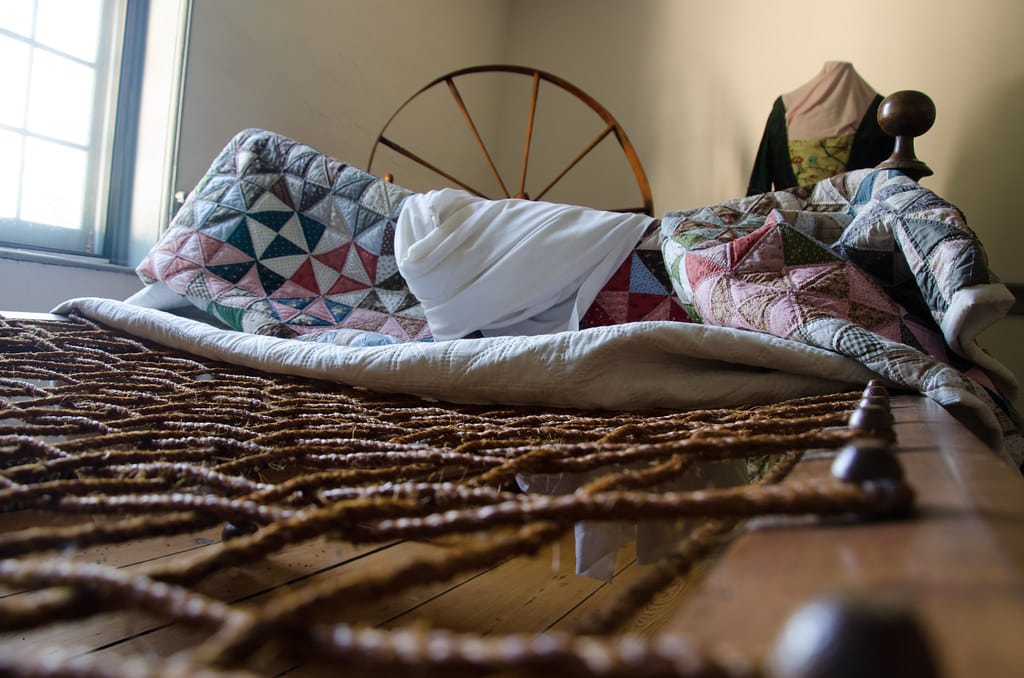 A rope bed is a type of bed that uses ropes or cords instead of a traditional mattress or springs for support. It typically consists of:
A rope bed is a type of bed that uses ropes or cords instead of a traditional mattress or springs for support. It typically consists of:
- A wooden frame: The base structure of the bed, made from wood or other materials.
- Ropes or cords: Stretched across the frame, providing support and comfort.
- Knots: used to secure the ropes to the frame and rate a flat surface.
Rope beds offer:
- Breathability
- Support
- Durability
- Unique aesthetic
However, rope beds may not be suitable for everyone, particularly those who prefer:
- Soft or plush mattress.
- High levels of comfort or support.
- Modern or luxurious bedding.
Overall, rope beds are a distinctive and functional sleeping solution that can add unique sleeping experience. The process of making rope bed is also very interesting which involves 8 steps:
Material selection: Choose durable ropes or cotton/jute and sturdy wood for the frame.
Frame construction: Build the bed frame using wooden planks, considering the desired size and design.
Rope preparation: Cut the ropes to the required length, leaving some extra for knotting.
Knotting: Tie nots at regular interval to crate the bed’s surface. Common knots include the square knot and bowline.
Tightening: tighten the ropes to create a firm surface.
Finishing: Add a natural finish (oil, wax) to protect the wood and ropes.
Assembly: Assemble the bed frame and attach the rope surface.
Final touches: Add any decorative elements, like carvings or upholstery.
Eco-Friendly and Sustainable
Rope beds are an environmentally-friendly option. The materials used, such as natural fibers like hemp or cotton, and wood for the frame, are sustainable and biodegradable. Compared to modern metal or plastic-based bed frames and box springs, a rope bed’s components have a much smaller environmental footprint.

A charm of “Rope Bed”
In an era of modern furniture, where sleek designs and luxurious materials reign supreme, the humble rope bed stands out as a testament to simplicity and tradition. This ancient sleeping platform, made from sturdy ropes and a wooden frame, has been a stable in many cultures for centuries. Despite its minimalist design, it exudes a unique charm that has captivated people around the world.
One of the primary attractions of is their rustic., earthy aesthetic. Unlike modern beds with their sleek lines and polished surfaces, rope beds boast a rugged, natural beauty that evokes a sense of simplicity and authenticity. The rough-hewn wood and weathered ropes create a cozy, organic feel that invites relaxation and tranquility.
Moreover, it promotes a healthier sleeping environment. Unlike modern mattresses, which can harbor allergens and dust mites, it allow for excellent airflow and breathability. This natural ventilation helps regulate body temperature and prevents moisture buildup, ensure a cooler, drier sleeping surface.
In addition to their functional advantages, it also hold a special place in many cultural traditions. In some African and Asian societies, they are an integral part of communal living serving as a central gathering point for socializing and storytelling. In other cultures, rope beds are revered for their symbolic significance, representing simplicity, humility, and a connection to the natura world.
In conclusion, the rope bed is a timeless sleeping platform that embodies the beauty of simplicity and tradition. Its rustic charm, durability, and health benefits make it an attractive alternative to modern furniture. As we increasingly seek to reconnect with our heritage and the natural world, the humble rope bed stands out as a testament to the enduring power of simplicity and tradition.
